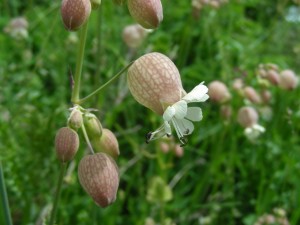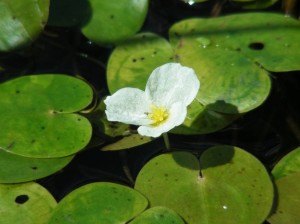February 2012
Green alien plant invaders of natural habitats: a lecture report written by Pauline Donaldson
The Mississippi Valley Field Naturalists (MVFN) recently held the 5th lecture of their 2011-12 natural history lecture series in Almonte. ‘Green Aliens in Lanark County’ was presented by Mississippi Mills resident Ken Allison, an avid field naturalist and professional biologist who specializes in non-native invasive plant species. Allison has served on the Board of Directors for MVFN for more than a year and is currently President of MVFN.
Prominent on the second slide of Allison’s MVFN presentation were the words “Lanark County has been invaded!” Invaded by plants that is. Gazing at the typical picturesque road-side scene filled with a pleasing, colourful array of familiar mid-summer wild flowers I am shocked as one by one they are named as alien species . . . Reed Canarygrass, wild carrot, bird’s-foot trefoil. However, it is a relief to hear that, to Allison, this class of alien plant species is not a worry as they do no harm in natural areas. In fact some of these alien invaders of disturbed habitats are popular with insects. Spotted knapweed is covered in skipper butterflies in July. Others like coltsfoot are a beautiful sight in spring with yellow flowers and masses of green leaves.
Some aliens are most welcome and bring other world culture to Canada, for example coltsfoot which is much admired from ancient times as a heal all. Invasive plants that flourish near the roadside tend to be salt tolerant. More natives grow further from the road. Alien invasive plants which are common in lawns are white clover and common plantain. Some non-native plants only manage to be invasive in cultivated fields or gardens, for example common purslane or yellow wood-sorrel. There are other non-native species which sometimes tend to persist where they are planted e.g. the common lilac or orange day-lily, but they do not become invasive. So far so good, these alien inhabitants of disturbed habitats seem okay, but there are other classes of alien plant species which “we really need to worry about” says Allison.
The ones to worry about are certain non-native aggressive invaders of natural habitats, both terrestrial and aquatic. These ‘bad’ alien invasive plants tend to share a number of characteristics. Number 1, they have extra good seed dispersal mechanisms – think dandelion seeds, or buckthorn berries. Or they can grow up in a crack in the pavement. Also, they are able to take advantage of man-made disturbances and invade places where we have reduced or eliminated the competition. Often a non-native plant that becomes invasive was introduced as an ornamental. If the answer is yes to the following questions then the non-native plant probably has potential to be invasive: Does it kill or suppress surrounding plants? Is it a rapidly spreading groundcover? Is it low maintenance? Are its seeds spread by wind or water? Are the berries eaten by wildlife?
Bladder companion is an alien plant which is common in disturbed habitats such as roadsides, where it does no harm. Photo Ken Allison
A ‘good’ example of a ‘bad’ alien plant invader of natural terrestrial habitats is European buckthorn (Rhamnus cathartica). Allison considers this “the worst of the worst locally”. It is a shrub that is easy to find in October because it is the only one still with leaves. It is displacing native species because its’ stands produce dense shade. There are other non-native plant invaders of natural terrestrial habitats which really do not do much harm, for example the pretty Herb Robert (Geranium robertianum). An example of an invasive orchid is the broadleaf helleboreine which invades on moist soil. It is also not having any apparent impact. Even some of these invasive species have benefited local insects. Henry’s elfin butterflies have learned to lay their eggs on glossy buckthorn.
Aquatic environments are especially vulnerable to invasive plants. Animal non-native invaders such as zebra mussels, a small clam, are quite well known. However an invasive plant species that is causing problems is European frog’s bit (Hydrocharis morsus-ranae). It is a free-floating aquatic plant with 3-petaled white flowers. This is a bad invader. It was brought in as an ornamental. Ducks and other waterfowl are probably partially responsible for its spread. It forms very dense floating mats which lead to a reduction of native plants and the dense growth out-competes other important plant and animal species for oxygen and nutrients in the water. Biological oxygen decrease is quite significant with frog’s bit. Another plant which has been a concern in wetland areas in the past was purple loosestrife. However, with bio-control measures in the form of two European beetle species which were released, this invader is becoming more civilized because the insects are keeping it down for now, but will this last? Common reed is another extremely aggressive non-native plant. Common reed loves ditches but it is unfortunately past worrying about. It is very invasive and out-competes all other native plants. It is still spreading in Eastern Ontario and the damage it does can be clearly seen nearby e.g. in the City of Montreal area. Another example of an invader of wetlands is Yellow flag (Iris pseudocorus).
European frog’s bit (Hydrocharis morsus-ranae) is an invasive free-floating aquatic plant with 3-petaled white flowers. It was brought in as an ornamental. In natural habitats it forms very dense floating mats leading to a reduction of native plants and animals as it depletes oxygen and nutrients. Photo Ken Allison
What can individuals do to stop the spread of invasive plants? Some obvious things to do include: Do not plant known invasive plants. Keep your land free of invasive plants. If you see something new, try to identify it. Often by the time it is identified it is beyond hope of eradication. As Allison says “you can’t put the genie back in the bottle.”
Invasion by plants and animals is a natural process and helps explain their evolution and distribution. However, the speed and frequency of these invasions is now greatly increased because of the impact of man. An optimistic note is that most invaders prosper only in habitats greatly modified by man. The retention of large amounts of native vegetation and habitats for native plants and animals is the best bet to keeping the most [natural and beneficial species] our land and waters provide.”
Allison showed a simple but effective time-line illustrating the stages of invasion of aggressive non-native plants. Typically, when an invasive is first introduced it is not noticed. As time goes by it’s numbers increase and it becomes more widespread. During this time it is noticed by the public and at some point after this there comes a time when it is beyond hope of eradication. If we can move identification by the public sooner, then the shape of the graph can be changed, and perhaps measures can be taken earlier to eradicate the plants, before it is too late to stop their spreading.
Allison named for us the ‘Top 10 Terrestrial Invasive Plants’ to watch for in the future: Japanese Knotweed, Japanese barberry, Garlic Mustard (is moving and may already be here in fill), Norway Maple (widely planted here. It escaped in New York state), Himalayan Balsam (an Impatiens-like jewel weed but it is purple), Russian Olive (an ornamental; not much in Lanark County but in Kanata areas are filling in with Russian Olive. It has the potential to be a bad invasive but it needs moisture and a disturbed area), Giant Hogweed (in southwestern Ontario now), Pale Swallowwort (is moving west; not yet in Lanark), Plumeless Thistle (most of Eastern Ontario seems to be an epicentre for this one), Spotted Knapweed (a prohibited noxious weed seed under the Canadian Seeds Act and Regulations; it is like steel wire and very difficult to pull).
The ‘Top 5 Aquatic Invasive Plants’ which Allison worries could become invaders of aquatic habitat in future i.e. the ones to watch out for include: Flowering Rush (a species which is doing well in Ottawa/Great Lakes), Water Soldier (in the same family as Frog’s Bit; it is in the Trent system and is spreading. It came in from aquaria and OMNR is trying to stop it), Water Chestnuts (in the Ottawa system and bad in Quebec), Carolina Fanwort (is in the Trent system; it survives because it sinks to the bottom for the winter), Floating Heart (has a yellow, fringed petals).
So, do not plant non –native species, and if you see something new in your area, try to identify it. If it is a new or uncommon species you can contact speaker Ken Allison at ken.allison@inspection.gc.ca or Lanark County wild plant expert David White may be interested in hearing about it. Is it one of the top 10 terrestrial or top 5 aquatic plants that may be moving into our area? Allison recommends the following references for plant identification: Plants of Lanark County, 2011 edition by David White and the website www.lanarkflora.com . Also Vascular Plants of the City of Ottawa, With the Identification of Significant Species a document by Dan Brunton – see http://ottawa.ca/calendar/ottawa/citycouncil/occ/2005/06-08/pec/AppendixA%20-%20OTTAWA%20FLORA%20(APR%2005).htm









